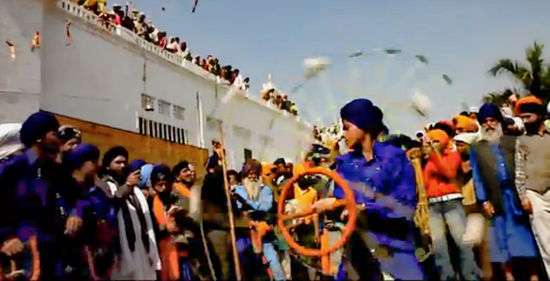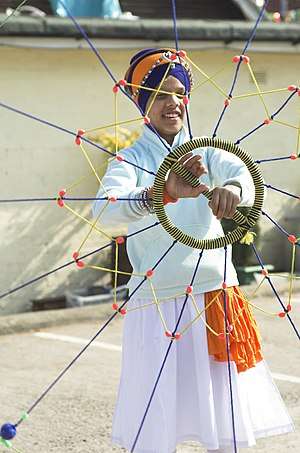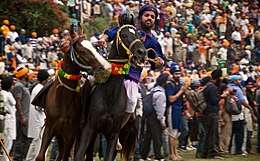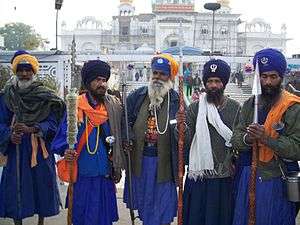Hola Mohalla
| Hola Mohalla | |
|---|---|
 | |
| Type | Sikh |
| Celebrations | Three-day[1] fair at Anandpur Sahib ending on Hola Mohalla day. Martial arts. |
| Date | Second day of lunar month of Chet |
| Frequency | Annual |
Hola Mohalla (Punjabi: ਹੋਲਾ ਮਹੱਲਾ, Hindi: होला मोहल्ला), also called Hola, is a one-day Sikh festival which most often falls in March[2][3] and takes place on the second day of the lunar month of Chett, a day after the Hindu spring festival Holi[4] but sometimes coincides with Holi.[5] Hola Mohalla is a big festive event for Sikhs around the world.
The fair held during Holi and Hola at Anandpur Sahib is traditionally a three-day event but participants attend Anandpur Sahib for a week, camping out and enjoying various displays of fighting prowess and bravery, and listening to kirtan, music, and poetry.[6] For meals, which is an integral part of the Sikh institution (Gurdwara), visitors sit together in Pangats (Queues) and eat vegetarian food of the Langars.[7] The event concludes on the day of Hola Mohalla with a long, military-style procession near Takht Sri Keshgarh Sahib, one of the five seats of temporal authority of the Sikhs.[8]
Etymology

Bhai Kahan Singh, who compiled the Mahan Kosh (the first Sikh encyclopedia) at the turn of the 20th century, explained, "Hola is derived from the word halla (a military charge) and the term mohalla stands for an organized procession or an army column. The words 'Hola Mohalla' would thus mean 'the charge of an army.' "[7] Dr. M.S. Ahluwalia notes that the related Punjabi term mahalia (which was derived from the root hal, meaning to alight or descend) refers to "an organized procession in the form of an army column accompanied by war drums and standard-bearers, and proceeding to a given location or moving in state from one to another."[2]
Hola is a Sanskrit word meant to be distinguished from Holi,[2] the Hindu spring festival of colors (Holi) which takes place the day before Hola Mohalla.[9]
History

The festival was founded by Guru Gobind Singh, the tenth Sikh Guru.[2] The Guru was in the midst of fighting both Aurangzeb of the Mughal Empire and the Hill Rajputs, and had recently established the Khalsa Panth.[2][8] On 7 March 1701, Guru Gobind Singh started a new tradition by overseeing a day of mock battles and poetry contests at Lohgarh Fort.[2][7] The tradition has since spread from the town of Anandpur Sahib to nearby Kiratpur Sahib and the foothills of the Shivaliks, and to other Gurdwaras around the world.[8]
According to Guru Gobind Singh's court poet Bhai Nand Lal, colours were thrown by the participants after completion of the mock battles.[10] Sikh tradition holds that Guru Gobind Singh also participated in the colourful festival[11][12] with the use of gulal[13] which has survived into modern times with Nihangs "splashing gulal (red farinaceous powder) on each other and the audience".[14][15] The alternative view is that the practice of throwing colours was not observed by Guru Gobind Singh.[16]
Hola Mohalla builds upon the festival of Holi. The Sri Guru Granth Sahib prescribes celebrating Holi by serving God.[17] The colours of Holi manifest in the Lord's love.[note 1]</ref> As Holi starts with Holika Dahan on the full moon night of Phagan or Phalgan, the festival of Holi is referred to as the festival of Phalgun even though the actual day of Holi falls on the first day of the lunar month of Chett. Sri Guru Gobind Singh Ji built upon this method of celebrating Holi by adding a martial element and creating Hola Mohalla to be celebrated a day after Holi.
Details
Hola Mahalla is a Sikh event which takes place on the second day of the lunar month of Chet, which usually falls in March.
Mahalia, is a Punjabi word that implies an organized procession in the form of an army column accompanied by war drums and standard-bearers, and proceeding to a given location or moving in state from one place to another.
Holi, when people playfully sprinkle colored powders, dry or mixed in water, on each other[19] on the first day of Chet was given a new dimension by establishing Hola to be celebrated a day after. However, Guru Gobind Singh (1666–1708) held the first march at Anandpur on Chet vadi 1, 1757 Bk (22 February 1701) and therefore festivities start before the second of Chet. In Anandpur Sahib, the festival lasts for three days.[1]
The Guru made Hola Mahalla an occasion for the Sikhs to demonstrate their martial skills in simulated battles. This was probably done to forestall a grimmer struggle against the imperial power and channeling people's energy into a more useful activity. Hola Mahalla became an annual event held in an open ground near Holgarh, a fort across the rivulet Charan Ganga, northwest of Anandpur sahib.
The popularity of this festival may be judged from the fact that out of five Sikh public holidays requested by the Khalsa Diwan, of Lahore in 1889, the Government approved only two - Hola Mahalla and the birth anniversary of Guru Nanak. Hola Mahalla is presently the biggest festival at Anandpur.
Anandpur Sahib
Anandpur Sahib (lit. City of Bliss) is situated on one of the lower spurs of the Shiwalik Hills in Ropar District of Punjab and is well connected with the rest of the country both by road and rail. It lies 31 km north of Rupnagar (Ropar) and 29 km south of Nangal Township. Being one of the supremely important historical centers of the Sikhs it has been reverently called Anandpur Sahib. It was here at Anandpur that on Baisakhi of 1699, Guru Gobind Singh inaugurated the Khalsa and the Panj Piare (the five beloved ones); hence inaugurating the order of Saint-Soldiers who pledged their dedication to defend the needy, poor and oppressed and their respective social, economic and political rights. This was a tradition of one of the world's greatest martyrs Guru Tegh Bahadur (the 9th Guru) who laid down his life in the defense of the Hindus on behalf of the Pandits of Kashmir.[20]
The order of the Khalsa, at the wish of Guru Gobind Singh's would henceforth be distinguished by five symbols (a uniform of 5Ks), viz. Kes (uncut hair), Kangha (comb), Kacherra (drawers), Kara (an all-steel bracelet) and Kirpan (a sword) so that they could easily be recognized by anyone under attack. Sikhs were further instructed to live to the highest ethical standards, and to be always ready to fight tyranny and injustice.[21]
Android App
District Administration has developed a mobile app named 'Hola Mohalla Suvidha' in collaboration with Smart IT Ventures for the facility of devotees visiting Kiratpur Sahib and Anandpur Sahib for Hola Mohalla From 25 February to 2 March. Devotees can download the app from Google Play Store.
Nihang Singhs

The Nihang are the members of the khalsa army known for their distinctive blue traditional robes and dumala, which are often embellished.[7] They are prominent at the Hola Mahalla festival.[22]
Notes
- ↑ The celebration is described as follows:[18]
One Universal Creator God. By The Grace Of The True Guru: I serve the Guru, and humbly bow to Him.
Today I am in supreme bliss.
My anxiety is dispelled, and I have met the Lord of the Universe.
Today, it is springtime in my household.
I sing Your Glorious Praises, O Infinite Lord God.
Today, I am celebrating the festival of Phalgun.
Joining with God's companions, I have begun to play.
I celebrate the festival of Holi by serving the Saints (Lord).
I am imbued with the deep crimson colour of the Lord's Divine Love.
My mind and body have blossomed forth, in utter, incomparable beauty.
They do not dry out in either sunshine or shade; they flourish in all seasons.
It is always springtime, when I meet with the Divine Guru.
The wish-fulfilling Elysian Tree has sprouted and grown.
It bears flowers and fruits, jewels of all sorts.
I am satisfied and fulfilled, singing the Glorious Praises of the Lord.
Servant Nanak meditates on the Lord, Har, Har, Har (God).
References
- 1 2 "Hola Mohalla". Society for the Confluence of Festivals in India. Retrieved 6 April 2018.
- 1 2 3 4 5 6 Ahluwalia, M.S. (November 2004). "Tourism: The Festival of Hola Mohalla". SikhSpectrum.com Quarterly (18). Retrieved 2008-09-14.
- ↑ Amolak Singh. "Sikh Calendar". SikhWorld.co.uk. Retrieved 2008-09-17.
- ↑ Yang, Ananad. A. (1998) Bazaar India: Markets, Society, and the Colonial State in Gangetic Bihar University of California Press
- ↑ Fieldhouse, Paul (2017) Food, Feasts, and Faith: An Encyclopedia of Food Culture in World Religions [2 volumes]. ABC-CLIO
- ↑ Amolak Singh. "Sikh Ceremonies". SikhWorld.co.uk. Retrieved 2008-09-17.
- 1 2 3 4 "The Hola Mohalla Festival". SikhChic.com. March 2007. Retrieved 2008-09-17.
- 1 2 3 T. Singh (15 August 2008). "Celebrating Holi". Reflections On Gurbani. Retrieved 2008-09-17.
- ↑ "Hola Mahalla". BBC Religion & Ethics. British Broadcasting Corporation. 28 August 2002. Retrieved 2008-09-14.
- ↑ Gandhi, Surjit Singh (2004) A Historian's Approach to Guru Gobind Singh. Singh bros
- ↑ Fenech, Louise.E> (2013)The Sikh Zafar-namah of Guru Gobind Singh: A Discursive Blade in the Heart of the Mughal Empire. OUP USA
- ↑ The Sikh Review, Volumes 16-17 (1968)
- ↑ Gandhi, Surjit Singh (2007) History of Sikh Gurus Retold: 1606-1708 C.E. Atlantic Publishers
- ↑ Census of India, 1961: Punjab
- ↑ Kamalpreet Singh Gill (01.03.2018) CULTURE Hola Mohalla: A Colourful Festival Of Courage, Hope, And Faith For Sikhs
- ↑ Punjab district gazetteers, Volume 9 (1987)
- ↑ Talib, Gurbachan Singh (1991) Sri Guru Granth Sahib in English Translation, Volume 4. Punjabi University
- ↑ Sri Guru Granth Sahib Ji
- ↑ Arnej, Simran Kaur.Ik Onkar One God
- ↑ "Religions - Sikhism: Guru Tegh Bahadur". BBC. Retrieved 20 October 2016.
- ↑ Davinder Singh. "Hola Mohalla Anandpur sahib Celebration". Retrieved 2015-02-12.
- ↑ Neena Chaudhry. "Festival of war". Singh Sabha of NY. Archived from the original on 2009-04-12. Retrieved 2009-05-20.